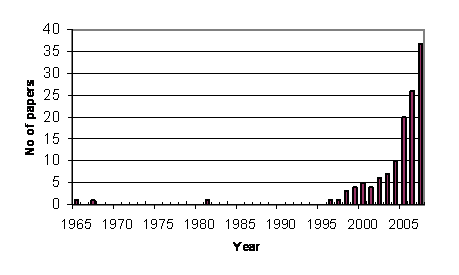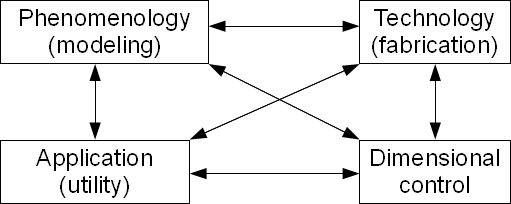Stage 1
The lubrication of textured surfaces became in the last years a subject with an outstanding dynamics in the field of research (Fig.1). In consequence a part of the activity from the present stage was focalized on updating the informational database by including the publications that appeared in the last year and a half. Taking into account the extremely rapid diversity of the STX applications and also the development of the technologies for the realization of STX, the synthesis of this information contained only the applications from the field of tribology and machine elements with direct applicability in automotive industry, from the piston ring-cylinder liner couple to other friction couples. In exchange, the applicability of texturing in the case of journal bearings is not practically found in the literature, with the exception of one bibliographic reference appeared recently, where the dimples have extremely large dimensions.
 |
|
Fig. 1. Evolution of the articles about tribology of
textured surfaces
|
The synthesis of the publications disclosed a new field of applications
which are the nonconformal contacts, in consequence the experimental activities
planed in this phase are shifted to the sphere-plan contact. The principal
operational parameters of these experiments which will take place in the
beginning at the Tribology Laboratory and subsequently on a journal bearing
test rig of a partner are presented in the report.
Another important element is that the majority of the theoretical or
experimental studies are focalized on the role of texturing as control for
friction. The increase of the ennergetic efficiency and the reduction of the
pollutant effects of the motor vehicles, fundamental objectives of the present
project, are strongly determined by the reduction of friction at the level of
the whole vehicle, and also the reduction of its mass (Fig.2). Although the
majority of the applications pursue the friction reduction, there exist
applications where the increase of friction is desired (for EHD transmissions
and fluid film transmissions) and for which texturing is a solution.
Another characteristic of the evolution of surface texturing, relevant for
recent studies, is the diversity of the profiles and dimensions of the dimples
and also a development of texturing using channels of different forms,
dimensions and orientation.
 |
|
Fig. 2. Influence of the reduction off mass respectively
friction on fuel consumption
|
Following the extensive analysis of texturing technologies of surfaces, a large diffusion of laser ablation technology can be remarked. The activities of this stage were dedicated mainly to the analysis of practical solutions of laser texturing of plane surfaces and interior cylindrical surfaces. The technological facilities and execution tolerances are analyzed, opening the way to the solutions of micro and nano-texturing. The difficulty of realization of this analysis necessitated dedicated studies which conducted to the establishment of the design principles of the texturing equipments which will be realized in the next phase. The tribological analysis of friction couples with textured surfaces includes four intercorelated aspects (poles), like it is schematized in Fig.3. The unilateral approach of one of these aspects is practically impossible.
 |
|
Fig. 3. Correlation of the aspects related to the study of
the application of STX in Tribology
|
*** Future Road Vehicle Research – A Roadmap for the Future – 9th EAC International Congress FURORE, 18 iun 2003, Paris